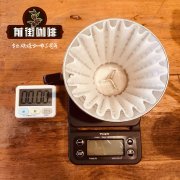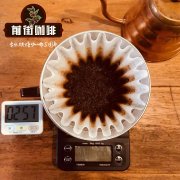How about Congolese coffee? how about Congolese coffee beans? how about Congolese coffee beans?

Professional coffee knowledge exchange more coffee bean information please follow the coffee workshop (Wechat official account cafe_style)
Minova, a town once beset by a dark history of war and sexual violence, is today trying to get rid of its past. Eba & Wally, founder of Societe Maitea, hopes to use coffee production to open a path to economic success and social stability, bring change to local communities and demonstrate the quality of coffee in the Democratic Republic of the Congo, especially in Kivu.
Minova is located in the northern part of Kivu province in the south of the Democratic Republic of the Congo (DRC), near the border with Rwanda and on the upper reaches of the Bay of Cabuno (Kabuno Bay); it lives at the top of Lake Kivu. The town has grown significantly since 1994, mainly due to the influx of refugees caused by the first and second Congolese wars and subsequent fighting in the region, resulting in many people being malnourished and lacking sense of security. Unfortunately, the town of Minova is often associated with terrible events of the past. In 2012, Congolese soldiers entered the town after an unsuccessful clash with M23 rebels and carried out a series of horrific sexual assaults. As a result, the town is famous for the "Minova trial" in 2014, the largest rape court in the history of the Democratic Republic of the Congo. Minova's trial hopes to bring these people to justice. However, only a small number of junior officers were found guilty of wrongdoing during the trial, which sparked outrage in the international community and later led to a summit against rape in war in London. Today, a few years later, Minova and South Kivu seem to be getting rid of their dark past.
Since 2014, the region's economy has gradually begun to grow; thanks to the help of international partners, they have come to buy coffee. Unfortunately, these initial purchase prices are very low. This means that problems such as malnutrition, health and education remain untreated. In 2018, Eba & Wally, the owner of Societe Maitea, joined. Eba Murua (biologist and primatologist) and Wally Mahindu (enthusiastic and comprehensive coffee expert) are working tirelessly to shake off the notoriety of the Kivus and improve the social development of their people. With the help of their extraordinarily hard-working team, this year (2019), Societe Generale and local cooperatives have been able to produce the first fully washed Arabica coffee from a cleaning station in Minova.
South Kivu benefits from fertile soil. This makes the area a rich agricultural base, and compost is the only fertilizer needed. In 1960, the Democratic Republic of the Congo ended its colonial rule and distributed a small piece of land to each farmer. This means that the average person owns less than one hectare of land, which means that each farm tends to produce only 750 kilograms (12 bags) of coffee a year. In order to increase their income, farmers grow a variety of other agricultural products, such as beans, corn and bananas; provide stable income throughout the year.
Although the trend in Minova is beginning to change, farmers in the region still face challenges such as access to land, security and, in particular, the threat of climate change. Due to its location near the equator, the Democratic Republic of the Congo has two bumper harvests each year; the main crop is in winter, plus a smaller fly crop in summer. Eba and Wally point out that it is very difficult to predict or plan which of the two is larger because of abnormal weather changes. This in turn led to a decrease in production and total output in the region.
To solve this problem, the World Coffee Organization (WCR) and the National Agricultural Research Institute (INERA) are experimenting with new varieties to increase production and help the region's specialty coffee thrive. Bourbon traditionally dominates most of the region, including neighbouring Rwanda and Burundi; it was originally introduced and funded by international organizations during the colonial period. Although some progress has been made, professional coffee has only just gained a foothold among producers in the Democratic Republic of the Congo, coffee production is still mainly Robusta economy, and the market share of professional coffee is less than 25%.
There is an average of one washing station every 2km in the region, and Societe Maitea uses its Lake Kivu base to process and classify coffee brought by farmers. Coffee is processed in "daily batches" and classified and evaluated. First, coffee cherries are sorted on a canvas bed; anything unpopular, such as unripe beans or coffee shells, is removed. Next, soak the cherries in clean cold water and float to separate high-quality cherries (floats). Any sinking fruit is removed and is usually sold on the internal market or used as compost. Next, beat the coffee fruit into a pulp and ferment it in a dry fermentor for 12 hours (from 8pm to 8am). Finally, before brewing the coffee, the coffee is washed to remove the final impurities and bad colored parchment
END
Important Notice :
前街咖啡 FrontStreet Coffee has moved to new addredd:
FrontStreet Coffee Address: 315,Donghua East Road,GuangZhou
Tel:020 38364473
- Prev

Ethiopia's Best Coffee Brand | G1 washing from Sheffield Village, Cochel Town, Yega Xuefei production area
Professional coffee knowledge exchange more coffee bean information please follow the coffee workshop (Wechat official account cafe_style) front street-Ethiopia Yega Sheffield Cochel Town Xuefu Village G1 brief introduction Ethiopia washed Yega Sheffield Cochel Town Xuefu Village G1 Ethiopia Yirgacheffe Kochere Shifo Washed G1 flavor description: White flower notes, sweet peach, full
- Next

Ethiopian G1 Idi Dodulo small Farmer Solar Yega Chuefei Flavor Berry Strawberry
Professional coffee knowledge exchange more coffee bean information please follow the coffee workshop (Wechat official account cafe_style) front street-Ethiopia Sun Yega Xuefei G1 Edidudulo small Farmers introduction to Solar Yega Xuefei G1 Edidudulo small Farmers Ethiopia Yirgacheffe Idido Tilahun Dulo G1 Natural Ethiopia Solar Yega Xuefei G1 Edidudu
Related
- Beginners will see the "Coffee pull flower" guide!
- What is the difference between ice blog purified milk and ordinary milk coffee?
- Why is the Philippines the largest producer of crops in Liberia?
- For coffee extraction, should the fine powder be retained?
- How does extracted espresso fill pressed powder? How much strength does it take to press the powder?
- How to make jasmine cold extract coffee? Is the jasmine + latte good?
- Will this little toy really make the coffee taste better? How does Lily Drip affect coffee extraction?
- Will the action of slapping the filter cup also affect coffee extraction?
- What's the difference between powder-to-water ratio and powder-to-liquid ratio?
- What is the Ethiopian local species? What does it have to do with Heirloom native species?

